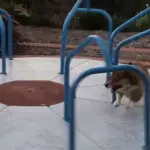Mythbusters: Canine Version
"A warm, dry nose means a dog is sick."
Many dog owners will check their pet’s nose if they suspect he’s not feeling well, but the temperature and moisture of a dog’s nose isn't indicative of the animal’s health. In fact, it’s normal for a dog’s nose to be warm and dry if he’s just woken up. 
However, if your pet’s nose is consistently dry or if it’s crusted, this could be a sign of a health problem and you should see a veterinarian.
"Dogs don’t see in color."
It was once thought that dogs could see only in black and white, and many people still believe this is the case. However, dogs do see in color — they just see color differently than we do.
While human eyes contain three kinds of color-sensing "cone" cells, dogs have only two, enabling them to see colors like blue, purple and gray most easily.
Dogs have lower visual acuity, which makes their vision blurrier than ours; however, they’re able to sense brightness, contrast and motion.
"Dogs’ mouths are cleaner than ours."
While you may have heard many people say this, the reality is that dogs’ mouths are full of bacteria. After all, dogs often chew whatever they find on the ground, they lick themselves, and they don’t brush their teeth nearly as often as we do. However, a dog’s dental bacteria is often different from ours.
The best way to keep your dog’s mouth clean is to make sure he’s dewormed and vaccinated and to clean his teeth regularly.
"Dogs eat grass to throw up."
While some dogs may chomp on grass to induce vomiting, it’s likely your canine simply likes the taste of grass, so if your yard isn't chemically treated, there’s no cause for concern.
Dogs may also graze because of a nutritional deficiency. If your dog consistently eats grass, talk to your veterinarian about introducing some vegetables into his diet.
However, if your dog frequently eats grass and vomits, visit your veterinarian.
"If a dog wags its tail, it’s happy."
While tail-wagging can indicate happiness, that’s not the only thing it can communicate. Sometimes a wagging tail can be a sign of fear, anxiety or even aggression.
Instead of looking at just a dog’s tail to determine its mood, consider the animal’s overall body language.
"You can't teach an old dog new tricks."
Despite this popular saying, dogs can learn new tricks at any age. In fact, dogs require mental stimulation at all ages of life, just like we do, so it’s beneficial to teach your canine companion new skills and commands. 
As long as your dog is healthy and responsive, and the trick is within its physical capabilities, there’s no reason your old dog can’t learn a new trick.






